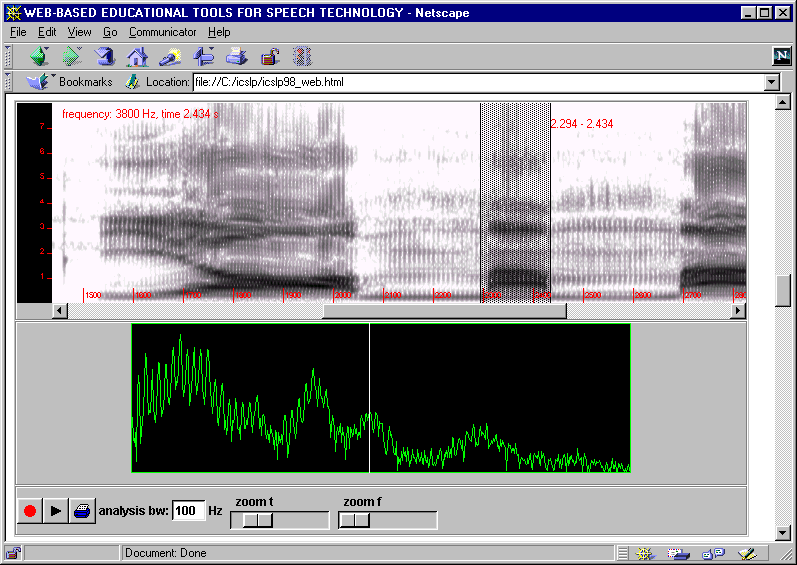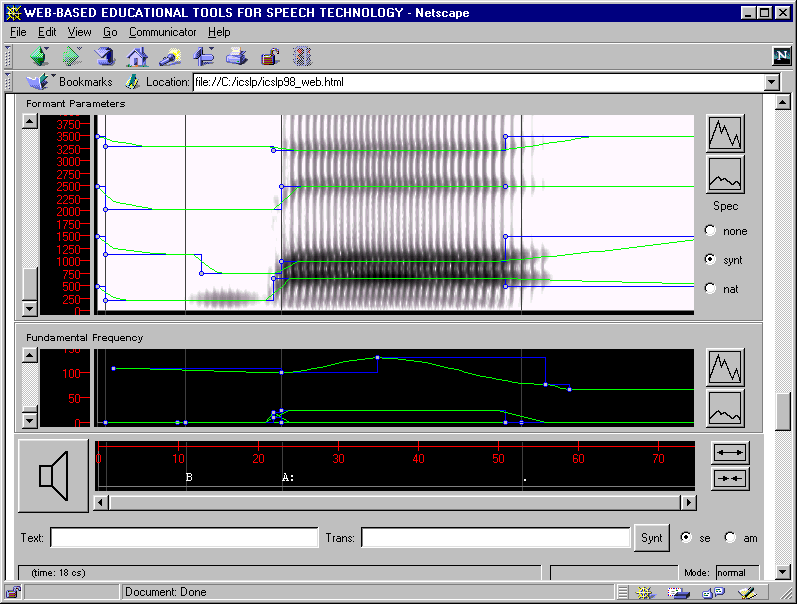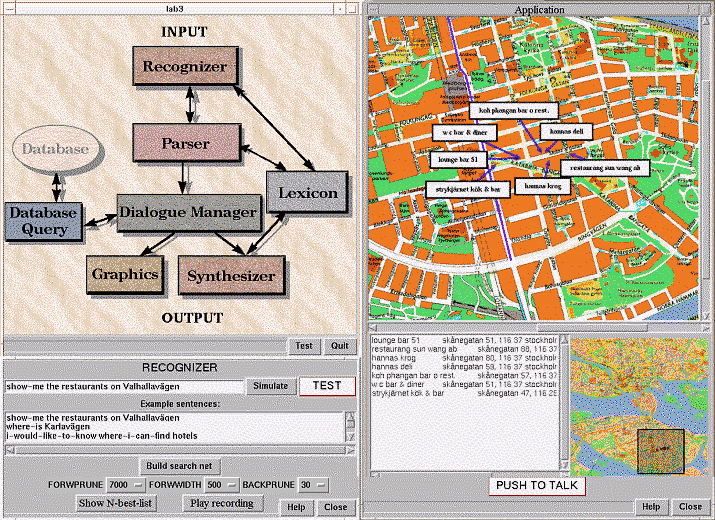Creating web-based exercises for
spoken language technology
Joakim Gustafson, Kåre Sjölander, Jonas Beskow, Rolf
Carlson and Björn Granström
Department of Speech, Music and Hearing, KTH
{joakim_g, kare, beskow, rolf, bjorn}@speech.kth.se
ABSTRACT
This paper describes the efforts at KTH in creating web-based exercises
for speech technology. The World Wide Web was chosen as our platform in
order to increase the usability and accessibility of our computer exercises.
The aim was to provide dedicated educational software instead of exercises
based on complex research tools. Currently, the set of exercises comprises
basic speech analysis, multi-modal speech synthesis and spoken
dialogue systems. Students access web pages in which the exercises
have been embedded as applets. This makes it possible to use them in a
classroom setting, as well as from the students' home computers.
1 INTRODUCTION
The speech group at KTH has developed a number of speech technology tools
for use in education of undergraduate students or researchers in the speech
field. Earlier, such tools were often developed for a certain computer
environment and needed teacher guidance because of their complexity. When
the number of speech technology students started to grow, during the last
couple of years, the need for more flexible solutions became apparent.
One important aim has been to provide dedicated instructional software
instead of research tools. Recently, we have added issues like platform
independence and intuitive user interfaces to our design goals. Another
one is the possibility to use our software over the Internet. The aim is
to free the students from the need of using a particular computer at a
particular time and place.
Our courses on speech technology include an introductory section on
basic phonetics and speech analysis. A set of exercises for this section
has been developed in which students analyse their own speech in various
ways. An interactive tool for working with parametric speech synthesis
has been developed. The tool facilitates editing of parameter tracks, and
it provides real-time feedback of the synthesised speech. It serves as
an interface to KTH's multilingual rule based synthesis system, and can
be used to control a formant synthesiser as well as a 3-D "talking head".
The integrated lab environment GULAN [1] for spoken dialog systems has
seen further development in the area of dialogue management [2] in co-operation
with the NLP lab at the University of Linköping. The system has also
been redesigned for web deployment.
2 IMPLEMENTATION
A speech technology toolkit that serves as a basis in the creation of spoken
language systems has been developed. A number of programming languages
are used in the modules of our toolkit. C/C++ is used where maximum performance
is required, for example, for the speech recognition and speech synthesis
engines. The Tcl/Tk language is used for user interfaces and as a glue
language in some modules. It was chosen because it is platform independent
and makes it simple to integrate existing modules and applications as well
as changing and extending these. It also has powerful and easy to use networking
facilities. The main drawbacks of the Tcl language are its execution speed
and its primitive syntax. However, this can be overcome by implementing
complex and time critical code in a more powerful language. Also, it is
possible to run scripts which are embedded in web pages and which download
quickly because of their relatively compact text representation. In all,
this is an ideal solution for computer based instruction and distance learning.
A new addition is the design of an architecture for communication between
programs on different computers using the Internet, the Broker Architecture
[3]. The Broker Architecture relays function calls, results and error conditions
between modules in text form over standard TCP internet connections. The
Broker is written in Java and the modules themselves are written in a number
of languages.
3 SPEECH ANALYSIS MODULE
One of our extensions to the Tcl language is the Snack speech analysis
module [4]. It provides a uniform interface to the audio hardware on a
number of platforms, adding commands to play, record and manipulate sound
in many audio formats, as well as disk I/O in common audio file formats.
Also, it has streaming audio capabilities which makes it easy to create
client/server audio applications. There are commands that allow the visualisation
of sounds using waveforms, spectrograms, and spectrum sections. The Snack
module serves as a basis when creating customised recording tools, speech
analysis applications, audio annotation tools, demonstrators, and the like.
The module has a powerful and intuitive way of handling sound as objects.
A spectrogram object connected to a sound object will update automatically
and in real time as the sound data changes. The modules also support postscript
printing in order to create hard copies or, for example, to make it possible
to create illustrations. Currently, it is possible to write platform independent
scripts which run on Unix (Linux, Solaris, HP-UX, IRIX) and Windows95/NT
using the Snack module. It is also possible to run scripts embedded in
web pages through the use of the Tcl plug-in. The Snack module, in source
and binary format, can be freely downloaded from http://www.speech.kth.se/snack/
An
example of how this module can be used follows:
#!/usr/local/bin/wish
package require snack
sound snd
pack [spectrogram .s -sound snd -height 200]
pack [button .r -text Record -com {snd record}]
pack [button .t -text Stop -command {snd stop}]
The example creates a simple real time spectrogram application. A sound
object called snd is created, which is empty initially. Next, a spectrogram
is created, that is linked to the sound. And finally two buttons labeled
Record and Stop. When clicked, these buttons will execute the commands
record and stop, respectively, of the sound object. As the recording commences
the spectrogram will update in real time to reflect the changing contents
of the sound object. There are numerous options to handle analysis bandwidth,
scales, and similar properties. The example script could easily be extended
with for example the ability to play a recording:
pack [button .p -text Play -command {snd play}]
In order to be able to save the recording the following line could be
added:
pack [button .w -text Save -com {snd write
[tk_getSaveFile]}]
Also, the script above would run without modification if embedded in
a web page, except for the save function that would need special privileges.
3.1 Speech Analysis Exercises
In our courses on speech technology we have an introductory section
on basic phonetics and speech analysis. For this section a set of exercises
were developed in which students analyse their own speech in various ways.
These exercises are accessed through web pages, in which simple speech
analysis tools have been embedded as small applications (applets) dedicated
to the task at hand (http://www.speech.kth.se/labs/analysis/).
In this way it was possible to make these exercises available to students
working in our laboratory, at Linköping University, as well as those
working from their home computers. The big advantage of using a web browser
as a platform is that all installation issues are solved, except for the
download and installation of plug-ins. Instructions and other useful information
can also accompany the tools in a natural and easily accessible way, using
HTML. A screen-shot of one of the exercises is shown in Figure 1. The exercises
covered measurements of vowel formant frequencies, comparisons of speakers
and speaking styles, Swedish word accent, and phonetic segmentation.

Figure 1. A screen-shot of one of the speech analysis
exercises
3.2 Using Snack in general applications
The object oriented approach makes Snack easy to use when building
spoken dialogue systems, where a sound object can be associated to one
or several speech recognition engines [5]. As soon as the sound is changed
the associated recognisers automatically generate n-best-lists of utterances
that are sent to a pre-defined function.
Another key feature is the possibility to use the Snack package in conjunction
with software developed at other sites, such as the CSLU Toolkit [6]. Snack
is currently in use at a number of sites, some of which have also contributed
in the development process or extended it for internal use. A prime example
of a tool using Snack is Transcriber [7] from DCE/CTA and LDC, for annotation
of broadcast material.
4 SPEECH SYNTHESIS TOOL
An interactive tool for working with parametric speech synthesis has been
developed. This tool facilitates editing of parameter tracks, and it provides
real-time feedback of the synthesised speech. It serves as an interface
to KTH's multilingual rule based synthesis system [8], and can be used
to control a formant synthesiser as well as a 3-D "talking head" [9]. The
parameter tracks, generated with KTH's rule based system, are also being
used to control a Mbrola diphone synthesiser with a Swedish voice together
with an animated agent [5]. The synthesis tool can run either as a stand-alone
application or as an applet in a Web browser. It has been used in research
and education. It gives full control over all parameters involved in the
formant synthesis process, including formant frequencies and bandwidths,
fundamental frequency and voice source parameters. The user can select
a language (Swedish, French, American English or German) and synthesise
arbitrary text, either in orthographic or phonetic mode. Once the phonetic
transcription has been generated, the synthesiser produces the control
parameter tracks in a two-step process: First, the phonetic rules generate
a series of control points for each parameter that define a target track.
Next, filters are applied to the target track to create a smoothed continuous
track to be output to the synthesiser. The filter type and coefficients
may differ between parameters, and the filter coefficients for a given
parameter may vary in time, under the control of another parameter.
The main interface, shown in Figure 2, consists of a number of panels
that display the parameter tracks, a time scale, a menu bar, a horizontal
scrollbar and a status bar. Each of the panels has an associated value-scale
and controls for vertical zooming and scrolling. The panels are stacked
and aligned vertically, in such a way that all panels share the same time
scale, and horizontal scrolling affects all panels. Typically, related
parameters or parameters of the same unit are displayed together in one
panel. The default configuration contains three panels, displaying formant
parameters, fundamental frequency and source parameters respectively. The
parameter tracks in the formant panel can be overlaid on top of a spectrogram.
Parameter tracks are edited in an intuitive way by dragging the control
points. Control points can be freely inserted or deleted, and segment durations
can be lengthened or shortened using a time scale at the bottom of the
display.

Figure 2. A screen-shot of the speech synthesis tool Veiron.
4.1 Speech Synthesis Exercises
Students are given a number of tasks to accomplish using the editing
tool. The first task is to change the identity of the consonant in a synthesised
CV syllable by manipulating the formant transitions. For example, to change
/ba/ to /da/, the transitions of the second and third formant into the
vowel part will have to be changed from rising to falling. In the second
task, the students apply the knowledge gained in the previous speech analysis
exercises, where they study the pitch contour of Swedish tones. Using a
set of minimal pairs with respect to tone, the task is to synthesise the
first word in the pair and manipulate the F0 contour to arrive at the other
word. A similar exercise involves changing the meaning of a word by modifying
vowel length, vowel quality and stress. The last task is to experiment
with prosodic modifications at sentence level, such as changing a statement
into question.
Formant based synthesis is sometimes compared to more commercially popular
synthesis methods based on concatenation of segments recorded from natural
speech. Concatenation based synthesis can offer high voice quality, but
is limited in flexibility. Typically, only pitch and duration can be altered
freely. In contrast, we feel that formant based synthesis has a significant
pedagogical value. By using a parametric synthesis paradigm based on a
familiar phonetic representation controlled from intuitive graphical interface,
exercises can be designed that provide the students with a deeper understanding
not only of fundamental speech synthesis techniques, but also about acoustic-phonetic
correlates in general.
An important feature of the parameter based speech synthesis is the
possibility to add new parameters for the animated talking head, so that
these can be edited in the same framework as the audio parameters. This
feature will be used in a dialogue lab assignment at MiLaSS, the European
summer school on Multimodality in Language and Systems. In this assignment
the students will be divided into groups, generating one half of a computer-computer
dialogue. They will use our tools to generate synthetic speech with appropriate
prosody, facial gestures and head movements.
5 EDUCATIONAL DIALOGUE SYSTEM
The educational dialogue system GULAN [2] has been redesigned into an application
that is accessed through a web page. In this dialogue system users can
make simple queries in the web-based Yellow Pages on selected topics using
speech. Results are presented using a combination of synthesised speech
and an interactive map. Our aim is to give the students hands-on experience
by letting them use the system on their own, examining it in detail, and
extending its functionality. In this way, we hope to give them an understanding
of the problems and issues involved in building dialogue systems and to
spur their interest in spoken dialogue technology and its possibilities.
Recently, the system has been redesigned with an improved dialogue manager
described in [3]. The system can also make use of the broker for modules
such as recognition and synthesis if it must run on slow computer.

Figure 3. A screen-shot of the educational dialogue system Gulan.
5.1 Dialogue System Exercises
The students were given a set of tasks to complete. First of all they
had to use the system in order to figure out what it could and could not
do. This also included experimenting with the speech recognition component
itself in order to understand its current limitations regarding, for example,
speaking style, vocabulary, and grammar. They could also change the pruning
parameters used in the recogniser and re-generate n-best-lists of probable
utterances for the last user input, thus making it possible to study their
effect on speed, quality and number of hypothesis generated. The principal
task was to extend the system with new fields from the Yellow Pages. New
words and phrases had to be added to the lexicon and the grammar had to
be modified accordingly. This is an interactive process where the students
can listen to the transcriptions using the text-to-speech system. Immediately
after they have loaded the updated lexicon into the running recogniser
they can use the new words. They also have to extend the text generation
capabilities in order to handle the new fields. The students could also
modify the prosodic patterns of the synthesised responses.
6 CONCLUSIONS AND FUTURE WORK
In this paper, some our efforts in creating web-based exercises for speech
technology have been presented. It has been useful to liberate our students
from the need to use certain computers or special laboratory set-ups at
certain hours. In fact, it has become necessary since the total number
of students has risen from about 20 to 200 in two years and one of our
courses was given at Linköping University.
Much remains to be done, but the basic framework has shown its strength.
Our current systems will be continuously developed and extended. The speech
analysis module will be expanded in order to make re-synthesis possible
in conjunction with the speech synthesis tool. The educational dialogue
system will be improved. Modules for multi-modal synthesis and prosodic
analysis will be added, as well as dialogue dependent speech recognition
and speech synthesis.
We believe that using the Internet will play an increasingly important
role in making speech technology available anywhere for educational and
co-operative purposes. Our investment in the web-based modular approach
has already paid off in terms of effortless portability and easy implementation
of demonstrators[5]
7 REFERENCES
-
Sjölander, K., and Gustafson, J. (1997) An Integrated
System for Teaching Spoken Dialogue Systems Technology, in Proceedings
of Eurospeech '97.
-
Gustafson, J., Elmberg, P., Carlson, R., Jönsson, A.
(1998) An educational dialogue system with a user controllable dialogue
manager, in Proc. of ICLSP´98.
-
Lewin E., (1998) The Broker Architecture, http://www.speech.kth.se/proj/broker/.
-
Sjölander, K., (1997) The Snack Sound Visualization
Module, http://www.speech.kth.se/snack/.
-
Gustafson, J., Lindberg, N. and Lundeberg, M. (1999) The
August spoken dialogue system, to be published in proceedings of Eurospeech'99.'
-
Sutton, S. et a. (1998) Universal Speech Tools: The CSLU
Toolkit, in Proceedings of ICLSP´98.
-
Barras, C., Geoffrois, E., Wu, Z. and Liberman, M (1998)
Transcriber: a Free Tool for Segmenting, Labeling and Transcribing Speech,
First International Conference on Language Resources and Evaluation. http://www.etca.fr/CTA/gip/Projets/Transcriber/
-
Carlson, R., Granström, B., and Hunnicutt, S. (1982)
A multi-language text-to-speech module, Proceedings of ICASSP '82, Paris,
Vol. 3, pp 1604-1607, 1982.
Beskow, J. (1995) Rule-based Visual Speech Synthesis,
in Proceedings of Eurospeech '95.
|


